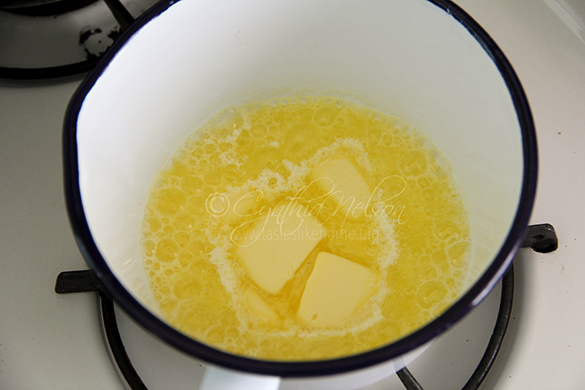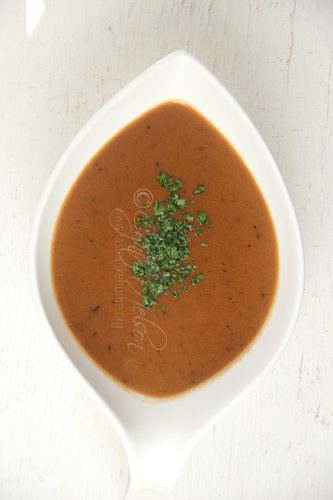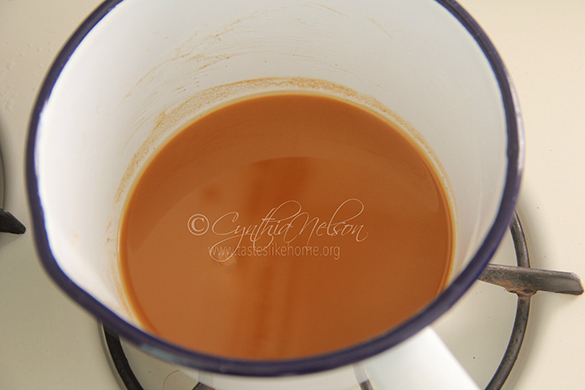 What’s Cooking is a series in which I answer questions and share advice about food and cooking that you have but may be too shy to ask.
What’s Cooking is a series in which I answer questions and share advice about food and cooking that you have but may be too shy to ask.
It can get lost amongst the mountainous platters of meats and starches, or the expansive trays of more attractive looking fare, however, not be missed when all has been laden on to our plates is the gravy. That almost nondescript thick sauce in its little boat or bowl. For many, a meal is not complete without gravy, it ties everything together, making every mouthful sumptuous.
The question several people wanted to know was – how to thicken gravy. Gravy is a type of sauce generally made from the juices of meats that run during the cooking process. The sauce is thickened with either wheat flour or corn starch, giving it texture and body.

For me, the best gravy is made with the drippings/juices from the roast and baked meats, simply because they are full of meaty flavour and umami. All the stuck-on bits at the bottom of the pan or baking dish is concentrated umami, and that right there is the base for great tasting gravy. However, these days, when entertaining, or even cooking for the family, there are some who eat meat and others who don’t, therefore, if you have the time, you can make 2 sets of gravy or 1 vegetarian gravy that everyone can enjoy.
Let’s expand a little and discuss how to make gravy, not only how to thicken gravy. Gravy is a combination of 4 things – some type fat, liquid, thickener and seasoning.

The fat
Butter, oil or the rendered fat from roasts or baked meats can all be used to make gravy. Let your choice be dependent on what you have available and whether or not you have non-meat eaters who will be consuming the gravy.
The liquid
The meat juices that run from the meat during the cooking process are perfect for a rich gravy with good depth of flavour; stock (meat, seafood or vegetable) as well as water are liquids used to make gravy. Heavy cream and various types of milks can also be added to gravy for extra richness, colour and flavour.
The thickener
Wheat flour, corn starch and potato starch are the most common starches used to thicken gravy. Each one can be made into a slurry. A slurry is made by adding equal parts of liquid and a thickening agent (flour, corn, potato starch) making a watery concoction that is then added to stews, soups, and sauces to thicken them.
When making gravy, the thickener can be cooked at the start of making the gravy or several minutes before the gravy is done cooking. Let me explain.
A roux is equal amounts of a fat and wheat flour cooked together at the beginning of certain sauces, the liquid is then added and the sauce cooks until it thickens to the desired consistency. This is the process by which the thickening of the gravy process is at the start of cooking. On the other hand, a slurry is usually added a several minutes before the gravy/sauce is due to finish cooking. It is stirred into the pot or pan and left to cook until the sauce thickens to the desired consistency. No method is better than the other; use the one you prefer and find easiest.
The seasoning
The seasoning is simply salt and pepper, however, other flavour-seasonings such as herbs and spices can be added to enhance the flavour of gravy. Pass the gravy through a sieve to remove the herbs and spices before serving.
Seasoning as in salt and pepper, should only be added towards the end of cooking. Here’s why. The volume of the liquid at the start of cooking is going to reduce and concentrate, therefore, if you season at the beginning, you are likely to add more salt than is necessary. And here’s another important thing about seasoning – if you are using stock or the cooked meat juices/drippings, they already contain salt so be sure to taste before seasoning with salt.
How to make gravy – with a roux
1. 2 tablespoons butter
or fat from drippings
2. 2 tablespoons flour
3. 1½ cups stock
4. Salt and pepper to taste
● Melt butter/heat drippings in a pan over medium heat
● Add in flour and stir to incorporate; keep stirring to avoid lumps and until the mixture browns, this will take about 5 minutes. The darker in colour the roux gets that will be the colour of the gravy. Therefore, if you want your gravy golden, reduce the heat to low and cook the roux for less time.
● Pour in stock, whisking as you pour to prevent lumps; keep stirring and bring to a boil and cook until gravy is thickened to your desired consistency. Season with salt and pepper to taste and cook for another minute.
How to make gravy – with meat juices/drip pings
● Measure the pan juices and add to a pot. Now add half of the amount of water of the measured pan juices as well to the pot. In other words, if you have 1 cup pan juices, add ½ cup water to that to make the gravy.
● Place over medium heat and stir well to mix, bring to a boil, reduce heat to low and simmer for 5 minutes.
● Make a slurry using 1 tablespoon corn starch with 1 tablespoon tap water.
● Raise heat to medium, pour in cornstarch mixture – keep stirring/whisking as you pour. Cook until gravy thickens. Taste and season if necessary.
To make gravy with stuck-on bits at the bottom of the pan/dish
● Pour 1½ cups boiling water into the pan/dish, and using a whisk, stir to mix and simultaneously release
the stuck-on bits (think de-glazing). Pour everything into a saucepan and place over medium heat and bring to a boil and cook for 6 minutes.
● Make a slurry with 1½ tablespoons of corn starch and pour into gravy, stirring/whisking as you do so. Continue to cook on medium heat until sauce thickens to your desired consistency. Taste for seasoning and adjust to suit.
The gravy will thicken as it cools so you can remove it from the heat a couple minutes shy of doneness or keep it someplace warm before serving. Remember to give it a good stir if not serving immediately.









